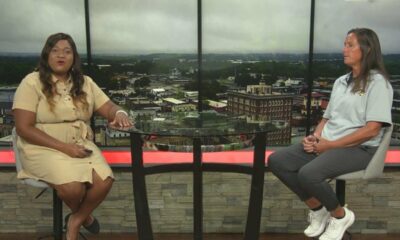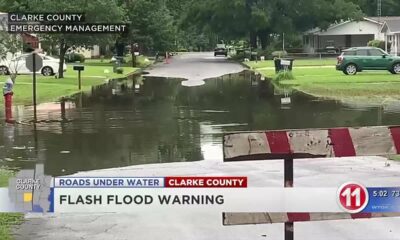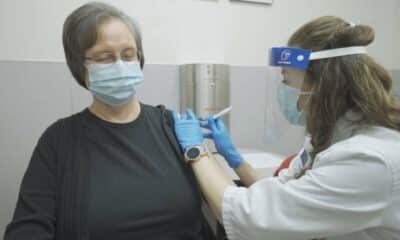Kaiser Health News
California’s Medicaid Experiment Spends Money to Save Money — And Help the Homeless
by Angela Hart
Wed, 19 Apr 2023 09:00:00 +0000
SAN DIEGO — Sporting a bright smile and the polished Super Bowl ring he won as a star NFL player in the late 1980s, Craig McEwen doesn't fit the archetype of someone teetering on the brink of homelessness.
Evicted from his San Diego County apartment last July, McEwen — who endured repeated concussions during his six seasons in the NFL — scoured housing listings for anything he could afford.
Working as a part-time groundskeeper at a golf course for $15 an hour, his frantic search turned up nothing. So, feeling overwhelmed by rents pushing $3,000 a month for a one-bedroom apartment, he made a plan: move into his truck or rent a storage container to live in — an alternative he turned to when he was previously homeless in 2004.
McEwen is hopeful that a massive health care initiative in California offering new, specialized social services will help him get back on his feet. He is one of nearly 145,000 low-income Californians enrolled in CalAIM, an endeavor Gavin Newsom, the state's Democratic governor, is spearheading to transform its Medicaid program, called Medi-Cal, into a new kind of safety net that provides housing and other services for people who are homeless or at risk of becoming homeless and have complicating conditions like mental illness or chronic disease that can make it difficult to manage life.
California launched the initiative in early 2022, rolling it out quietly, with health insurers and community groups scrambling to provide social services and benefits that fall outside traditional health care. It's a five-year, $12 billion social experiment that Newsom is betting will eventually cut soaring health care spending in Medi-Cal, the largest Medicaid program in the country with 15.5 million enrollees.
The state is contracting the work to its 23 Medi-Cal managed-care health insurance companies. They are responsible for delivering a slew of new benefits to the most vulnerable enrollees: not only those with housing insecurity, but also people with mental health or addictive disorders; formerly incarcerated people transitioning back to society; seniors and people with disabilities; children in foster care; and Californians who frequent hospital emergency rooms or are admitted often to short-term skilled nursing facilities.
While only a sliver of the state's Medi-Cal patients are enrolled in CalAIM, tens of thousands of low-income Californians could qualify for the new benefits. They're eligible for help in finding housing and for paying rental move-in costs like security deposits.
But the help goes beyond housing. The state is also providing the most at-risk patients with intensive case management, alongside pioneering social services — such as healthy home-delivered meals for diabetes patients and mold removal in homes of patients with severe asthma.
Top state health officials say that with such an ambitious program — using Medicaid to help solve homelessness and combat chronic disease — they expected the rollout to be bumpy. After 2026, when the initiative's funding ends, the state plans to prove the experiment works and permanently adopt the benefits. Meanwhile, other states are closely watching California, hoping to learn from its successes and failures.
“California is a leader, and it's always experimenting in new and interesting ways,” said Dr. Georges Benjamin, executive director of the American Public Health Association. “What it can do is provide proof of concept, and then this can grow to other states.”
Insurers, in essence, are building a new health care workforce, contracting with nonprofit and for-profit organizations to enroll the most vulnerable — and expensive — Medi-Cal patients. They're hiring social workers and case managers to find those who rack up extreme health care costs in hospital emergency rooms, nursing homes, prisons, jails, and mental health crisis centers.
As Newsom sees it, the immense investment will pay off for taxpayers. Targeting people cycling in and out of costly institutions will reduce health care spending, he argues, while also helping people get healthy. State health officials say 5% of high-need Medi-Cal patients account for roughly half of all health care spending in the low-income health care program.
The most important currency in pulling off this massive health care experiment is trust. And that is being built on the ground, with community outreach workers scouring hospitals and homeless encampments, for example, to find those eligible for CalAIM.
The most at-risk Medi-Cal patients are being linked to specialized teams deployed under a new entitlement benefit at the heart of the initiative called “enhanced care management.” While other services like covering security deposits are optional, this is not. Health insurers are required to accept people who are most in need and provide a wide range of health and social services.
It can be simple things like arranging an Uber to get to a medical appointment or buying a computer for an enrollee looking for a job. Or purchasing a bike for a low-income kid. But it also involves intensive, one-on-one work that can require case managers to take patients to get an identification card, make nighttime phone calls to ensure patients are taking medications, and hunt down available apartments.
“This is the missing piece, and it's the hardest work — the most costly work,” Newsom said in an interview with KFF Health News. “People on the streets and sidewalks, they've lost trust. They've become socially isolated. They've lost connection, and so developing that is so foundational.”
‘My Own Prison'
McEwen, who was a tight end for the NFL team now known as the Washington Commanders and later for the San Diego Chargers, was hailed as a “legacy.” But playing professional football took an extreme toll.
“My position was to block for the quarterback, and back in the day, you were allowed to hit people in the head,” McEwen said, recalling regular concussions on the field that he'd snap himself out of by sniffing ammonia packets. He helped lead the Washington team to a Super Bowl victory in 1987, but in the decades since, his health has deteriorated.
McEwen has struggled for years to find regular work while dealing with thoughts of suicide, anger, forgetfulness, and depression that he says stem from traumatic brain injuries sustained during his football career. At 57, he endures continual pain from ruptured disks in his neck and spine, along with shortness of breath from severe heart disease.
He'd holed up in his apartment for years, with curtains nailed to his windows, drowning his pain with alcohol. “I basically created my own prison,” he said.
After he was evicted last July, a longtime friend swooped in to let him stay temporarily in a spare bedroom at his family's house just outside San Diego. But McEwen's financial and emotional struggle to find stable housing hasn't ended.
“We don't call it fear. Us ballplayers, we call it excitement,” McEwen said on a rainy morning in early March, his eyes swelling with tears. “I'm excited. I know what's at stake. My life is at stake.”
Housing instability is just one part of it. He'd often forget to take his medications for high cholesterol and clogged arteries. He felt paralyzing anxiety and his brain was so scrambled he'd miss important doctor appointments — a side effect, he said, of the concussions.
McEwen knew he needed help.
He'd learned from a friend that California was helping Medi-Cal patients with not just medical needs but also social services, and he started making calls, insisting on getting in. “I said wait, you're giving people a coach? Someone who can make appointments for me and go to my doctor visits with me?”
Weeks after receiving his eviction notice, his Medi-Cal insurer, Molina Healthcare, connected him with a personal care manager, whom McEwen calls “my advocate, someone who can teach me how to do for myself and give myself a life worth living.”
But who gets in the program is often a roll of the dice, depending largely on which Medi-Cal insurance company a person is enrolled in. Persistence plays a big role.
Despite early glimmers of hope, the rollout has been chaotic. Providers on the ground scramble to find any available housing for enrollees. Groups implementing the initiative say inadequate funding and dire health workforce shortages have severely constrained their ability to serve all those in need. And enrollment by health insurers is uneven, with some quickly approving new benefits for their members while others are denied. Some insurers provide on-the-spot Uber rides for doctor appointments while others offer only a bus pass.
“What is being offered is insufficient, and this program is not set up to support those who are actually the most vulnerable and need the most intensive support,” said Nancy Behm, associate director of CalAIM for a San Diego nonprofit called People Assisting the Homeless, or PATH.
Operating under contracts with Blue Shield of California, Molina Healthcare, and Health Net, PATH launched intensive case management and housing services in January 2022. But it has since stopped providing intensive case management benefits largely due to a lack of sufficient funding to do the grueling work of connecting with homeless people living in encampments. “We're hitting barriers on every front,” Behm said.
Newsom, with his soaring political ambitions, is promising to help the most vulnerable Californians. Termed out in 2026, speculation is mounting that the two-term governor is eyeing a presidential run, and he's using health care as a core issue to elevate his national profile. In reality, his Medi-Cal initiative is falling far short.
“This is an extremely ambitious program, but it doesn't come close to helping the entirety of the population it's targeting,” said Doug Herman, who worked for former President Barack Obama and former Los Angeles Mayor Eric Garcetti. “This isn't a policy solution big enough to really make a dent in homelessness.”
No Walk in the Park
On a brisk morning in late February, Jeannine Nash pulled into the drive-thru of a Jack in the Box in Chula Vista, just south of San Diego. She dug in her wallet to find $8.17 for 10 breakfast sandwiches to hand out to homeless people on her regular rounds visiting encampments.
“It helps me to come out here before work, to get an idea of what the needs are,” Nash said as she approached a nearby homeless woman slumped over on a sidewalk who had nothing with her but a brand-new walker and hospital discharge paperwork tucked in a plastic bag.
Nash is director of referrals for Serene Health, a for-profit health care company that is one of nearly 500 provider organizations being paid to link homeless people or those at risk with intensive case management, housing, and other services.
A recovering addict herself, Nash said her life experience has helped her connect with people living outside and struggling with substance use disorders. She figures out how to get those who appear resistant to accept services. “So many people are distrustful of authority,” said Nash, who has a son who is homeless.
“This is very, very dear to my heart,” Nash said. In her decades since becoming sober, she has gained deep experience getting the people most at risk of spiraling deeper into crisis into treatment beds and even apartments. She's cultivated relationships with housing and nursing home agencies so she can quickly identify openings.
But her job comes with extraordinary challenges. She often has to level with people living outside, telling them there is simply nowhere for them to go. “There's just not enough beds or housing out there,” she said. “And if you don't have an income, it's not going to happen.”
Nash handed the homeless woman in the doorway two sandwiches, coaxing her to eat. The woman, Christina Gallegos, 38, was suffering from extreme liver damage due to chronic drinking and had crawled the few blocks from Scripps Mercy Hospital in Chula Vista, where she was discharged the night before.
She had been in the emergency room, her hospital discharge paperwork showed — one of several ER trips she'd made in the past month. She was given the walker but couldn't walk and dragged it into a doorway for shelter.
“We see this all the time. It's getting really bad,” Nash said, texting her contacts to find a bed for Gallegos. “She's definitely eligible. It's just finding somewhere for her to go that is going to be hard.”
Gallegos has Medi-Cal but hasn't been enrolled in the new benefits California is offering. She was among an estimated 8,500 homeless people identified in San Diego County in 2022, a 10% increase since 2020.
San Diego County is massive and populous, and while homeless encampments permeate suburban enclaves like Chula Vista, homeless people are largely clustered in San Diego's downtown neighborhood and its parks.
One popular place to pitch a tent is Balboa Park near the San Diego Zoo. Its canyons and sprawling green lawns are peppered with tent communities, whose inhabitants plead for help from community groups. Many hang on to business cards from homeless outreach workers in hopes of scoring a shelter bed or permanent housing. While some people do get housing, many feel as if outreach efforts amount to broken promises.
One man, David Lloyd, pulled from his pocket a phone number for an outreach worker from the homeless services provider PATH, who told him that he was on a waiting list for housing but that he could be waiting in the queue for years.
“It's a big list,” said Lloyd, 66. “I just want to get off the streets. I'm tired of the cops harassing me all the time.”
Cally Wood, 35, said she is addicted to fentanyl and has been on the waiting list for housing for more than a year. “It just feels really impossible,” she said. “There's nothing affordable.”
Health insurance executives, including Martha Santana-Chin, Medi-Cal president for Health Net in California, said Medi-Cal managed-care plans are making progress in helping get people off the streets and into services. Yet she acknowledged the initial rollout falls short.
“We just don't have the housing supply that we need,” Santana-Chin said, “to be confident that all of these folks who need support and services are going to get permanently placed.”
Hampered by Sweeps
Across the region, sweeps of homeless encampments are common and becoming part of everyday life for people living outside. Deteriorating and unsanitary conditions on the streets fuel public frustration.
Newsom has ratcheted up the practice of clearing encampments, arguing that people dealing with homelessness should not be allowed to live outdoors, despite a dearth of alternatives. He's allocating state funding to cities and counties to remove tents from streets and sidewalks and move people into any shelter or housing available. San Diego Mayor Todd Gloria, also a Democrat, is unapologetic about adopting the approach.
“We're doing the cleanups that are necessary for public safety,” Gloria told KFF Health News. “These conditions are unsanitary, and it puts people's health and safety at risk, and it leads to people dying. Some people disagree with me under the guise of caring for these individuals, but the sidewalk is not a home.”
Outreach workers on the ground, however, say the enforcement crackdown only makes their jobs harder. One of the most critical goals of the new Medi-Cal initiative is to regularly visit people on the streets, build relationships with them, and help them with health care needs, all while preparing them for housing — if it becomes available.
“This really takes a lot of time. Sometimes you start with just bringing someone socks or a bottle of water. It can take 70 encounters for someone to accept our help,” said Andrea Karrer, an outreach worker with PATH. “But that time is what allows you to build trust with someone, and when they have to constantly move, you have to find that person, and sometimes start all over.”
And the disruptions ultimately cause people without housing to get sicker and visit the ER more often, she and other outreach workers said.
“When you have to move every two or three days, getting to the doctor or staying on medication is not the biggest priority. You're in survival mode,” Karrer said.
A Labor-Intensive Effort
Serene Health is one of hundreds of providers enrolling Medi-Cal patients into intensive case management. Together, they have signed up 108,000 patients statewide so far, according to California's Department of Health Care Services, which administers Medi-Cal. An additional 28,000 are receiving the new housing services such as security deposit payments and help identifying affordable housing.
“A lot of the stuff we're doing is just really new to health care,” said Jacey Cooper, the state's Medicaid director. She said that health insurers are offering housing services in all 58 counties, yet she acknowledged that the need exceeds capacity.
“It takes time for that infrastructure to come to fruition,” Cooper said of the challenge of identifying housing for Medi-Cal patients who frequent hospital ERs. “We are in a massive education moment of even making sure people understand who's eligible and how to refer, and educating the entire delivery system, from hospitals to providers.”
Meanwhile, Newsom is asking the Biden administration for permission to add another housing benefit that would cover up to six months of direct rent payments.
Veronica Ortiz, a lead care manager for Serene Health, has Craig McEwen on her roster of about 60 patients — a large caseload that is difficult to manage.
But Ortiz bubbles with compassion and energy and said working with patients like McEwen has given her even more drive to make a difference. The work is arduous, but McEwen is quickly becoming more independent, she said.
“When we come into their lives, we're strangers, so we have to spend a lot of time meeting face-to-face with people and helping with anything they need, otherwise they're not going to trust us.”
But help didn't come fast enough for Donna Fontenot, a San Diego County resident who is being evicted from her apartment this month. Her landlord told her she had to leave following repeated ER trips, hospitalizations, and skilled nursing home stays stemming from an initial fall in 2022 that left her in a wheelchair.
“I'm petrified and absolutely panicking, I have nowhere to go,” Fontenot said. With one hospitalization alone costing an average of $18,000 in California, Fontenot, who is on Medi-Cal, has racked up high health care costs.
She has been hospitalized eight times since March 2022, she said. And on five occasions, her injuries to her feet and legs were so extreme that she needed placement in a nursing home.
Yet her Medi-Cal insurer, the San Diego-based Community Health Group, instituted a rule that to qualify for some housing services, she must have a child under 18. So she isn't receiving housing assistance that could help her. She is, however, enrolled in intensive case management. But she was not aware of that until KFF Health News informed her.
“I feel like I won the lottery,” she said. “Is it going to help me?”
Her care manager hasn't been as involved in her life as Ortiz has been with McEwen. Fontenot continues to search on her own for housing, and recently asked to be switched into Serene Health to get more hands-on assistance. “I've never needed help like this before. I feel so broken,” she said in tears. “Where am I going to go?”
Today, Ortiz is helping McEwen search for housing. She also has focused on helping him get his heart condition under control and find more stable work.
In March, he landed a job as a security guard patrolling sporting events, including at football stadiums. And he scored a hard-to-get surgery appointment for late this month to help unclog the arteries in his heart.
“Before Veronica, I was waiting to die. I was eating and drinking to die. But she showed up for me. Somebody cared about me. And that gave me the courage to share with her what my dream would be,” McEwen said. “I thought I needed football to be loved — then I'd be worth it.
“But I know now that my true purpose is to be of service and to be there for my daughter. I decided to get back on the field, instead of sitting on the sidelines.”
This article was produced by KFF Health News, which publishes California Healthline, an editorially independent service of the California Health Care Foundation.
KFF Health News is a national newsroom that produces in-depth journalism about health issues and is one of the core operating programs at KFF—an independent source of health policy research, polling, and journalism. Learn more about KFF.
USE OUR CONTENT
This story can be republished for free (details).
By: Angela Hart
Title: California's Medicaid Experiment Spends Money to Save Money — And Help the Homeless
Sourced From: kffhealthnews.org/news/article/california-homelessness-calaim-program-medicaid-experiment/
Published Date: Wed, 19 Apr 2023 09:00:00 +0000
Kaiser Health News
The Lure of Specialty Medicine Pulls Nurse Practitioners From Primary Care
Michelle Andrews
Fri, 17 May 2024 09:00:00 +0000
For many patients, seeing a nurse practitioner has become a routine part of primary care, in which these “NPs” often perform the same tasks that patients have relied on doctors for.
But NPs in specialty care? That's not routine, at least not yet. Increasingly, though, nurse practitioners and physician assistants are joining cardiology, dermatology, and other specialty practices, broadening their skills and increasing their income.
This development worries some people who track the health workforce, because current trends suggest primary care, which has counted on nurse practitioners to backstop physician shortages, soon might not be able to rely on them to the same extent.
“They're succumbing to the same challenges that we have with physicians,” said Atul Grover, executive director of the Research and Action Institute at the Association of American Medical Colleges. The rates NPs can command in a specialty practice “are quite a bit higher” than practice salaries in primary care, he said.
When nurse practitioner programs began to proliferate in the 1970s, “at first it looked great, producing all these nurse practitioners that go to work with primary care physicians,” said Yalda Jabbarpour, director of the American Academy of Family Physicians' Robert Graham Center for Policy Studies. “But now only 30% are going into primary care.”
Jabbarpour was referring to the 2024 primary care scorecard by the Milbank Memorial Fund, which found that from 2016 to 2021 the proportion of nurse practitioners who worked in primary care practices hovered between 32% and 34%, even though their numbers grew rapidly. The proportion of physician assistants, also known as physician associates, in primary care ranged from 27% to 30%, the study found.
Both nurse practitioners and physician assistants are advanced practice clinicians who, in addition to graduate degrees, must complete distinct education, training, and certification steps. NPs can practice without a doctor's supervision in more than two dozen states, while PAs have similar independence in only a handful of states.
About 88% of nurse practitioners are certified in an area of primary care, according to the American Association of Nurse Practitioners. But it is difficult to track exactly how many work in primary care or in specialty practices. Unlike physicians, they're generally not required to be endorsed by a national standard-setting body to practice in specialties like oncology or cardiology, for example. The AANP declined to answer questions about its annual workforce survey or the extent to which primary care NPs are moving toward specialties.
Though data tracking the change is sparse, specialty practices are adding these advanced practice clinicians at almost the same rate as primary care practices, according to frequently cited research published in 2018.
The clearest evidence of the shift: From 2008 to 2016, there was a 22% increase in the number of specialty practices that employed nurse practitioners and physician assistants, according to that study. The increase in the number of primary care practices that employed these professionals was 24%.
Once more, the most recent projections by the Association of American Medical Colleges predict a dearth of at least 20,200 primary care physicians by 2036. There will also be a shortfall of non-primary care specialists, including a deficiency of at least 10,100 surgical physicians and up to 25,000 physicians in other specialties.
When it comes to the actual work performed, the lines between primary and specialty care are often blurred, said Candice Chen, associate professor of health policy and management at George Washington University.
“You might be a nurse practitioner working in a gastroenterology clinic or cardiology clinic, but the scope of what you do is starting to overlap with primary care,” she said.
Nurse practitioners' salaries vary widely by location, type of facility, and experience. Still, according to data from health care recruiter AMN Healthcare Physician Solutions, formerly known as Merritt Hawkins, the total annual average starting compensation, including signing bonus, for nurse practitioners and physician assistants in specialty practice was $172,544 in the year that ended March 31, slightly higher than the $166,544 for those in primary care.
According to forecasts from the federal Bureau of Labor Statistics, nurse practitioner jobs will increase faster than jobs in almost any other occupation in the decade leading up to 2032, growing by 123,600 jobs or 45%. (Wind turbine service technician is the only other occupation projected to grow as fast.) The growth rate for physician assistants is also much faster than average, at 27%. There are more than twice as many nurse practitioners as physician assistants, however: 323,900 versus 148,000, in 2022.
To Grover, of the AAMC, numbers like this signal that there will probably be enough NPs, PAs, and physicians to meet primary care needs. At the same time, “expect more NPs and PAs to also flow out into other specialties,” he said.
When Pamela Ograbisz started working as a registered nurse 27 years ago, she worked in a cardiothoracic intensive care unit. After she became a family nurse practitioner a few years later, she found a job with a similar specialty practice, which trained her to take on a bigger role, first running their outpatient clinic, then working on the floor, and later in the intensive care unit.
If nurse practitioners want to specialize, often “the doctors mentor them just like they would with a physician residency,” said Ograbisz, now vice president of clinical operations at temporary placement recruiter LocumTenens.com.
If physician assistants want to specialize, they also can do so through mentoring, or they can receive “certificates of added qualifications” in 10 specialties to demonstrate their expertise. Most employers don't “encourage or require” these certificates, however, said Jennifer Orozco, chief medical officer at the American Academy of Physician Associates.
There are a number of training programs for family nurse practitioners who want to develop skills in other areas.
Raina Hoebelheinrich, 40, a family nurse practitioner at a regional medical center in Yankton, South Dakota, recently enrolled in a three-semester post-master's endocrinology training program at Mount Marty University. She lives on a farm in nearby northeastern Nebraska with her husband and five sons.
Hoebelheinrich's new skills could be helpful in her current hospital job, in which she sees a lot of patients with acute diabetes, or in a clinic setting like the one in Sioux Falls, South Dakota, where she is doing her clinical endocrinology training.
Lack of access to endocrinology care in rural areas is a real problem, and many people may travel hundreds of miles to see a specialist.
“There aren't a lot of options,” she said.
——————————
By: Michelle Andrews
Title: The Lure of Specialty Medicine Pulls Nurse Practitioners From Primary Care
Sourced From: kffhealthnews.org/news/article/nurse-practitioners-trend-primary-care-specialties/
Published Date: Fri, 17 May 2024 09:00:00 +0000
Did you miss our previous article…
https://www.biloxinewsevents.com/clean-needles-save-lives-in-some-states-they-might-not-be-legal/
Kaiser Health News
Clean Needles Save Lives. In Some States, They Might Not Be Legal.
Ed Mahon, Spotlight PA and Sarah Boden, WESA
Fri, 17 May 2024 09:00:00 +0000
Kim Botteicher hardly thinks of herself as a criminal.
On the main floor of a former Catholic church in Bolivar, Pennsylvania, Botteicher runs a flower shop and cafe.
In the former church's basement, she also operates a nonprofit organization focused on helping people caught up in the drug epidemic get back on their feet.
The nonprofit, FAVOR ~ Western PA, sits in a rural pocket of the Allegheny Mountains east of Pittsburgh. Her organization's home county of Westmoreland has seen roughly 100 or more drug overdose deaths each year for the past several years, the majority involving fentanyl.
Thousands more residents in the region have been touched by the scourge of addiction, which is where Botteicher comes in.
She helps people find housing, jobs, and health care, and works with families by running support groups and explaining that substance use disorder is a disease, not a moral failing.
But she has also talked publicly about how she has made sterile syringes available to people who use drugs.
“When that person comes in the door,” she said, “if they are covered with abscesses because they have been using needles that are dirty, or they've been sharing needles — maybe they've got hep C — we see that as, ‘OK, this is our first step.'”
Studies have identified public health benefits associated with syringe exchange services. The Centers for Disease Control and Prevention says these programs reduce HIV and hepatitis C infections, and that new users of the programs are more likely to enter drug treatment and more likely to stop using drugs than nonparticipants.
This harm-reduction strategy is supported by leading health groups, such as the American Medical Association, the World Health Organization, and the International AIDS Society.
But providing clean syringes could put Botteicher in legal danger. Under Pennsylvania law, it's a misdemeanor to distribute drug paraphernalia. The state's definition includes hypodermic syringes, needles, and other objects used for injecting banned drugs. Pennsylvania is one of 12 states that do not implicitly or explicitly authorize syringe services programs through statute or regulation, according to a 2023 analysis. A few of those states, but not Pennsylvania, either don't have a state drug paraphernalia law or don't include syringes in it.
Those working on the front lines of the opioid epidemic, like Botteicher, say a reexamination of Pennsylvania's law is long overdue.
There's an urgency to the issue as well: Billions of dollars have begun flowing into Pennsylvania and other states from legal settlements with companies over their role in the opioid epidemic, and syringe services are among the eligible interventions that could be supported by that money.
The opioid settlements reached between drug companies and distributors and a coalition of state attorneys general included a list of recommendations for spending the money. Expanding syringe services is listed as one of the core strategies.
But in Pennsylvania, where 5,158 people died from a drug overdose in 2022, the state's drug paraphernalia law stands in the way.
Concerns over Botteicher's work with syringe services recently led Westmoreland County officials to cancel an allocation of $150,000 in opioid settlement funds they had previously approved for her organization. County Commissioner Douglas Chew defended the decision by saying the county “is very risk averse.”
Botteicher said her organization had planned to use the money to hire additional recovery specialists, not on syringes. Supporters of syringe services point to the cancellation of funding as evidence of the need to change state law, especially given the recommendations of settlement documents.
“It's just a huge inconsistency,” said Zoe Soslow, who leads overdose prevention work in Pennsylvania for the public health organization Vital Strategies. “It's causing a lot of confusion.”
Though sterile syringes can be purchased from pharmacies without a prescription, handing out free ones to make drug use safer is generally considered illegal — or at least in a legal gray area — in most of the state. In Pennsylvania's two largest cities, Philadelphia and Pittsburgh, officials have used local health powers to provide legal protection to people who operate syringe services programs.
Even so, in Philadelphia, Mayor Cherelle Parker, who took office in January, has made it clear she opposes using opioid settlement money, or any city funds, to pay for the distribution of clean needles, The Philadelphia Inquirer has reported. Parker's position signals a major shift in that city's approach to the opioid epidemic.
On the other side of the state, opioid settlement funds have had a big effect for Prevention Point Pittsburgh, a harm reduction organization. Allegheny County reported spending or committing $325,000 in settlement money as of the end of last year to support the organization's work with sterile syringes and other supplies for safer drug use.
“It was absolutely incredible to not have to fundraise every single dollar for the supplies that go out,” said Prevention Point's executive director, Aaron Arnold. “It takes a lot of energy. It pulls away from actual delivery of services when you're constantly having to find out, ‘Do we have enough money to even purchase the supplies that we want to distribute?'”
In parts of Pennsylvania that lack these legal protections, people sometimes operate underground syringe programs.
The Pennsylvania law banning drug paraphernalia was never intended to apply to syringe services, according to Scott Burris, director of the Center for Public Health Law Research at Temple University. But there have not been court cases in Pennsylvania to clarify the issue, and the failure of the legislature to act creates a chilling effect, he said.
Carla Sofronski, executive director of the Pennsylvania Harm Reduction Network, said she was not aware of anyone having faced criminal charges for operating syringe services in the state, but she noted the threat hangs over people who do and that they are taking a “great risk.”
In 2016, the CDC flagged three Pennsylvania counties — Cambria, Crawford, and Luzerne — among 220 counties nationwide in an assessment of communities potentially vulnerable to the rapid spread of HIV and to new or continuing high rates of hepatitis C infections among people who inject drugs.
Kate Favata, a resident of Luzerne County, said she started using heroin in her late teens and wouldn't be alive today if it weren't for the support and community she found at a syringe services program in Philadelphia.
“It kind of just made me feel like I was in a safe space. And I don't really know if there was like a come-to-God moment or come-to-Jesus moment,” she said. “I just wanted better.”
Favata is now in long-term recovery and works for a medication-assisted treatment program.
At clinics in Cambria and Somerset Counties, Highlands Health provides free or low-cost medical care. Despite the legal risk, the organization has operated a syringe program for several years, while also testing patients for infectious diseases, distributing overdose reversal medication, and offering recovery options.
Rosalie Danchanko, Highlands Health's executive director, said she hopes opioid settlement money can eventually support her organization.
“Why shouldn't that wealth be spread around for all organizations that are working with people affected by the opioid problem?” she asked.
In February, legislation to legalize syringe services in Pennsylvania was approved by a committee and has moved forward. The administration of Gov. Josh Shapiro, a Democrat, supports the legislation. But it faces an uncertain future in the full legislature, in which Democrats have a narrow majority in the House and Republicans control the Senate.
One of the bill's lead sponsors, state Rep. Jim Struzzi, hasn't always supported syringe services. But the Republican from western Pennsylvania said that since his brother died from a drug overdose in 2014, he has come to better understand the nature of addiction.
In the committee vote, nearly all of Struzzi's Republican colleagues opposed the bill. State Rep. Paul Schemel said authorizing the “very instrumentality of abuse” crossed a line for him and “would be enabling an evil.”
After the vote, Struzzi said he wanted to build more bipartisan support. He noted that some of his own skepticism about the programs eased only after he visited Prevention Point Pittsburgh and saw how workers do more than just hand out syringes. These types of programs connect people to resources — overdose reversal medication, wound care, substance use treatment — that can save lives and lead to recovery.
“A lot of these people are … desperate. They're alone. They're afraid. And these programs bring them into someone who cares,” Struzzi said. “And that, to me, is a step in the right direction.”
At her nonprofit in western Pennsylvania, Botteicher is hoping lawmakers take action.
“If it's something that's going to help someone, then why is it illegal?” she said. “It just doesn't make any sense to me.”
This story was co-reported by WESA Public Radio and Spotlight PA, an independent, nonpartisan, and nonprofit newsroom producing investigative and public-service journalism that holds power to account and drives positive change in Pennsylvania.
KFF Health News is a national newsroom that produces in-depth journalism about health issues and is one of the core operating programs at KFF—an independent source of health policy research, polling, and journalism. Learn more about KFF.
USE OUR CONTENT
This story can be republished for free (details).
——————————
By: Ed Mahon, Spotlight PA and Sarah Boden, WESA
Title: Clean Needles Save Lives. In Some States, They Might Not Be Legal.
Sourced From: kffhealthnews.org/news/article/clean-needles-syringe-services-programs-legal-gray-area-risk-pennsylvania/
Published Date: Fri, 17 May 2024 09:00:00 +0000
Kaiser Health News
Watch: John Oliver Dishes on KFF Health News’ Opioid Settlements Series
Fri, 17 May 2024 09:00:00 +0000
Opioid manufacturers, distributors, and retailers are paying tens of billions of dollars in restitution to settle lawsuits related to their role in the nation's overdose epidemic. A recent broadcast of “Last Week Tonight With John Oliver” examined how that money is being spent by state and local governments across the United States.
The segment featured reporting from the KFF Health News series “Payback: Tracking the Opioid Settlement Cash.” You can learn more about the issue and read our collection of articles by Aneri Pattani here.
——————————
Title: Watch: John Oliver Dishes on KFF Health News' Opioid Settlements Series
Sourced From: kffhealthnews.org/news/article/watch-john-oliver-kff-health-news-payback-opioid-settlements-series/
Published Date: Fri, 17 May 2024 09:00:00 +0000
-
SuperTalk FM5 days ago
Martin Lawrence making 3 stops in Mississippi on comedy tour
-
Our Mississippi Home4 days ago
Beat the Heat with Mississippi’s Best Waterparks
-
Our Mississippi Home5 days ago
Charlie’s U-Pik: Opening Soon for the Summer Season
-
Mississippi News Video7 days ago
Local dentists offer free dental care in Amory
-
SuperTalk FM21 hours ago
State auditor cracking down on Mississippians receiving unemployment benefits
-
Mississippi News Video3 days ago
Jackson has a gang problem
-
Kaiser Health News4 days ago
Medicaid ‘Unwinding’ Decried as Biased Against Disabled People
-
Mississippi Today7 days ago
On this day in 1968




































